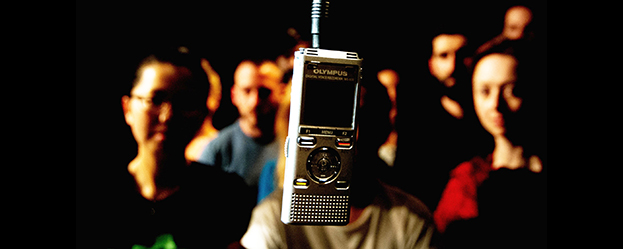This website uses cookies so that we can provide you with the best user experience possible. Cookie information is stored in your browser and performs functions such as recognising you when you return to our website and helping our team to understand which sections of the website you find most interesting and useful.
ED2014 Interviews ED2014 Theatre ED2014 Week0 Edition
Ramin Gray: Completing the Bard
By Chris Cooke | Published on Thursday 31 July 2014

“A writer reading ‘Hamlet’ for the first time is gradually losing his eyesight” says the show’s blurb. “As he realises he will never finish the play that he slept through when young, he calls on the audience to help”. Intrigued. What if I told you the dictaphone in the picture plays the key role in this play? That, and the audience. After winning a Fringe First last year for ‘The Events’, the Actors Touring Company commissioned Nassim Soleimanpour, perhaps best known for his play ‘White Rabbit Red Rabbit’, to write ‘Blind Hamlet’, a collaboration that has resulted in what is set to be one of the most ground breaking shows at the Festival. We spoke to ATC’s Artistic Director Ramin Gray to find out more.
CC: People over use the word ‘innovative’, but this REALLY is an innovative production. Can you fill us in on the premise?
RG: The Actors Touring Company commissioned a play from Iranian writer Nassim Soleimanpour and what he delivered was in the form of recordings on a dictaphone. We’ve decided to play those recordings to the audience, to see if people will follow his instructions to help us create the event that was in his mind’s eye.
CC: How will the interactive elements of the production work? Do ticket-buyers need to be ready for some audience participation?
RG: My brother hates theatre, but he’s addicted to cinema, and for a very simple reason: he knows that even in a big West End theatre, at some level the act of theatre will involve him, and will only work if he participates. He prefers to sit back in the cinema and let it all roll by. Well, ‘Blind Hamlet’ is certainly not for him. But I’d say that it’s merely a souped-up version of the basic act of theatre: to get something out of it, you need to put something in. And, yes, Nassim will be asking audience members to join his disembodied voice onstage.
CC: How different can each night be depending on how the audience reacts?
RG: Now I’ve told you about the dictaphone recordings, you’ll realise that ‘Blind Hamlet’ sets up a conflict between a very fixed, unchangeable thing, the recordings, and a live, unpredictable beast, the audience. But within those parameters, well, anything could happen.
CC: Should Fringe-goers come on multiple nights, to experience how a few differing reactions can change the show?
RG: I certainly hope we’ve packed in enough for the play to bear multiple viewings. And yes, the ending will be fresh and different every night, a bespoke finale for every audience.
CC: Are there any specific themes from ‘Hamlet’ explored in the play?
RG: Doubt. Perception. Action. Existence. Darkness.
CC: And would it help to brush up on your ‘Hamlet’ before coming along? Or maybe people should go and see one of the various productions of the play being performed at the Fringe this year first?
RG: Your Hamlet should always be kept well-brushed! It’s the play that contains all plays. But no, we made sure that no prior knowledge is necessary. Better to think of this as an original new play by Nassim Soleimanpour.
CC: How did the collaboration with Soleimanpour come about?
RG: I saw ‘White Rabbit, Red Rabbit’ up here at the Fringe three years ago and contacted him. He gives his email out in the play! And we struck up a creative, exciting dialogue. Being half Iranian myself, I found it particularly thrilling to be back in contact with the country, especially in these politically interesting times.
CC: I hear the piece has developed hugely in the rehearsal room. How does your partnership with Soleimanpour work?
RG: Like any good collaboration, it’s fractious, challenging, frustrating, pleasurable, intoxicating and tough.
CC: Following all the acclaim and awards your production of David Greig’s ‘The Events’ won last year, do you feel under particular pressure this Fringe?
RG: Well, I honestly never expected any of the acclaim, it was an added bonus. I think most people who do what we’re doing, just try to make stuff. And some of it works, a lot of it fails. As Beckett says, Fail. Fail better.
CC: Nevertheless, the Fringe seems like the perfect place for a ground-breaking piece of theatre like ‘Blind Hamlet’. Would you agree? And if so why?
RG: Yes, the Fringe is perfect to try out something like ‘Blind Hamlet’. There’s a supportive curiosity, a critical mass that buoys you up. You know a great deal of the time, we make stuff in darkness, in blindness. And it’s the audiences that allow us to see what we’ve done.
‘Blind Hamlet’ was performed at Assembly Roxy at Edinburgh Festival 2014.
LINKS: www.atctheatre.com
Photo: David Levine






